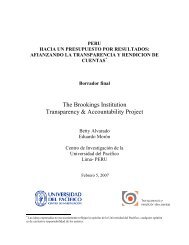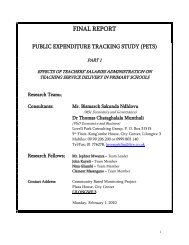Provider Purchasing and Contracting for Health Services_The Case
Provider Purchasing and Contracting for Health Services_The Case
Provider Purchasing and Contracting for Health Services_The Case
You also want an ePaper? Increase the reach of your titles
YUMPU automatically turns print PDFs into web optimized ePapers that Google loves.
Following independence in 1964, the health sector in Zambia was managed centrally through<br />
the Ministry of <strong>Health</strong> Headquarters. <strong>Health</strong> care financing <strong>and</strong> resource allocation were<br />
supported through the annual plans within the ministry’s headquarters. District <strong>Health</strong><br />
Management <strong>and</strong> Hospital Management Teams had no financial autonomy. <strong>The</strong>y prepared<br />
district <strong>and</strong> hospital plans that were then centrally funded. At most, they could hold “imprest”<br />
or advances of cash, which were retired through the usual financial accounting procedures of<br />
expenditures supported by appropriate documentation. Accountability was undertaken<br />
principally through the provincial accounting structures, which, in general, were also<br />
responsible <strong>for</strong> government sectors in addition to health.<br />
<strong>Health</strong> care personnel were employed <strong>and</strong> deployed through the Public Service Commission<br />
<strong>and</strong> on the payroll of the Ministry of Finance. <strong>The</strong> Central Statistical Office managed<br />
monitoring <strong>and</strong> evaluation, <strong>and</strong> it seconded officers to the Ministry of <strong>Health</strong> to assist in<br />
managing the monitoring <strong>and</strong> evaluation component. Essentially, there were virtually little or<br />
no known contracting ef<strong>for</strong>ts in existence in the public or private sectors. Moreover, district<br />
<strong>and</strong> hospital managers did not have authority to plan <strong>and</strong> manage financial or human<br />
resources. <strong>The</strong>y could not plan or set priorities based on prevailing health needs in their<br />
districts. Consequently, plans developed centrally did not reflect or address the health needs<br />
of the respective districts.<br />
Among the institutional re<strong>for</strong>ms of the mid-1990s was the separation of political <strong>and</strong><br />
executive functions of the Ministry of <strong>Health</strong>. <strong>The</strong> national government policy emphasized<br />
the role of ministries in policy development, resource mobilization, <strong>and</strong> monitoring of<br />
per<strong>for</strong>mance. <strong>The</strong> implementation role was delegated to semi-autonomous institutions. <strong>The</strong><br />
thrust of the re<strong>for</strong>m agenda was to establish a clear separation between the purchaser <strong>and</strong> the<br />
provider. In the health sector, the government passed the implementation role to the Central<br />
Board of <strong>Health</strong>, a body originally established under the 1930 Public <strong>Health</strong> Act <strong>and</strong><br />
recognized again in the 1995 National <strong>Health</strong> <strong>Services</strong> Act. Until 2006, the Ministry of<br />
<strong>Health</strong> was responsible <strong>for</strong> policy <strong>for</strong>mulation, strategic planning, <strong>and</strong> overall coordination,<br />
legislation, budgeting <strong>and</strong> resource mobilization, <strong>and</strong> external relations. Decentralization of<br />
the health services entailed the unbundling of the public sector to create internal markets,<br />
which allowed contracting at various levels of health (Lake et al. 2000).<br />
Thus, two parallel, but complementary, organizational structures were introduced, namely,<br />
popular structures <strong>for</strong> public involvement <strong>and</strong> participation in the decision-making process,<br />
<strong>and</strong> the technical <strong>and</strong> management structures, designed to ensure that health services were<br />
implemented <strong>and</strong> managed in a manner that was technically sound <strong>and</strong> in keeping with best<br />
practices. Apart from the Central Board of <strong>Health</strong> at national level, Hospital Management<br />
Boards, District <strong>Health</strong> Boards, <strong>and</strong> the Neighborhood <strong>Health</strong> Committees <strong>and</strong> <strong>Health</strong> Centre<br />
Committees, at the community level, were also created. On the other h<strong>and</strong>, the technical<br />
structures established included the management teams at the Ministry of <strong>Health</strong> <strong>and</strong> the<br />
Central Board of <strong>Health</strong> at the national level; Hospital Management Teams at the hospital<br />
level; <strong>and</strong> District <strong>Health</strong> Management Teams at the district level.<br />
Generally, the per<strong>for</strong>mance of the Zambian health sector has been tied to economy-wide<br />
developments since the early 1980s. During the late 1970s, economic growth in Zambia<br />
stagnated at an average of 1 percent per annum <strong>and</strong> started to deteriorate in the late 1980s to<br />
the early 1990s until 2000. <strong>The</strong> weak per<strong>for</strong>mance of the centrally planned economy resulted<br />
in a move toward plural politics <strong>and</strong> market-oriented economic policies.<br />
9
















